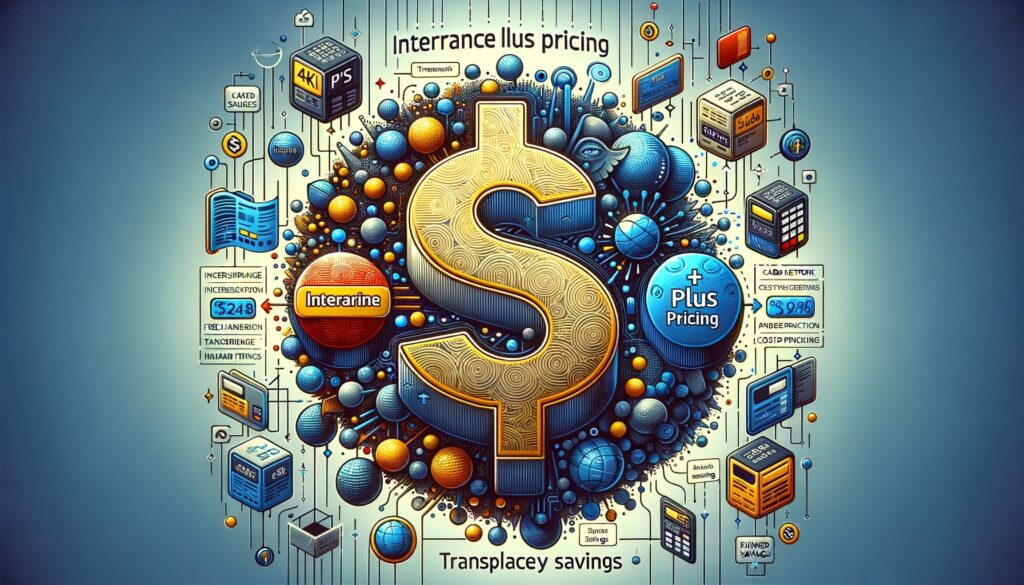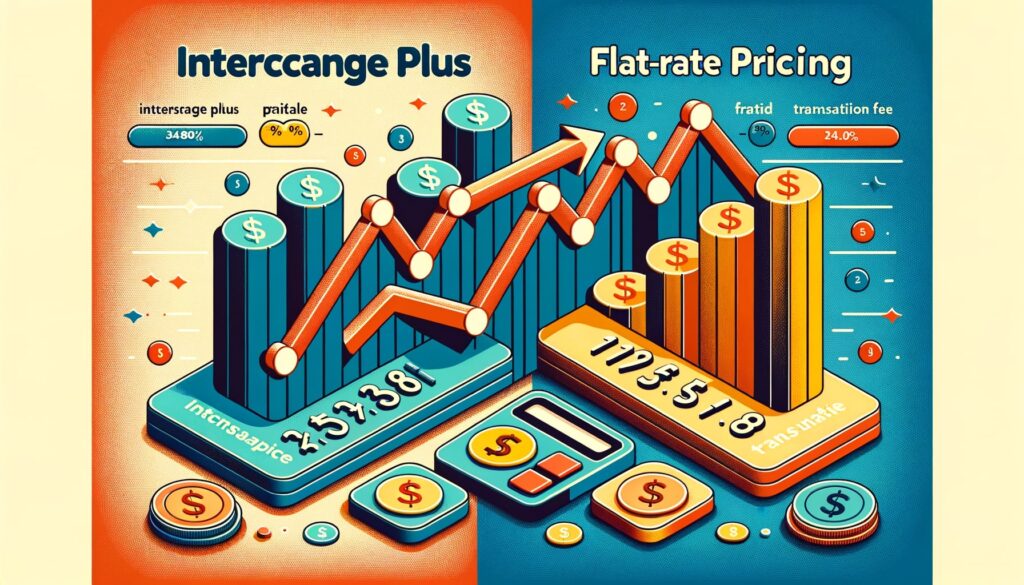
By American October 16, 2024
Small businesses are often searching for cost-effective and transparent solutions when it comes to credit card processing fees. One pricing model that has gained considerable popularity for its fairness and transparency is Interchange Plus pricing. This model is particularly beneficial for small businesses looking to reduce their payment processing costs while gaining better insight into the structure of fees associated with accepting credit and debit card payments.
In this comprehensive guide, we will explore the advantages of Interchange Plus pricing for small businesses, how it works, and why it is often a better option than other pricing models. We will also address common misconceptions, provide strategies for negotiating the best rates, and answer frequently asked questions related to Interchange Plus pricing.
What Is Interchange Plus Pricing?
Interchange Plus pricing is a credit card processing model that separates the interchange fees—set by the card networks (Visa, Mastercard, Discover, etc.)—from the processor’s markup fee. The term “interchange” refers to the fees charged by the card-issuing bank (the customer’s bank) to the acquiring bank (the merchant’s bank) for processing the transaction. The “plus” represents the fixed fee or percentage added by the payment processor for facilitating the transaction.
This pricing model is characterized by its transparency, as it clearly distinguishes between the costs that are beyond the control of the payment processor (interchange fees) and the processor’s own markup. For small businesses, this breakdown allows for a better understanding of where their money is going and helps identify areas where costs can be minimized.
How Interchange Plus Pricing Works
When a customer makes a purchase with a credit or debit card, the transaction involves several steps:
- Customer Checkout: The customer submits their payment information online, in-store, or over the phone.
- Authorization: The payment processor sends the transaction details to the card network (Visa, Mastercard, etc.), which verifies the transaction with the cardholder’s issuing bank.
- Interchange Fee Calculation: The card network sets the interchange fee based on the type of card used, the transaction method, and the merchant’s industry.
- Processor’s Markup: The payment processor adds its own markup (a fixed percentage or fee) to the interchange fee.
- Fund Transfer: Once the transaction is authorized, funds are transferred from the customer’s bank to the merchant’s account, minus the interchange fee and processor markup.
Example of Interchange Plus Pricing
Consider a small business that processes a $100 transaction with a Visa credit card. The interchange fee set by Visa is 1.75% + $0.10, and the processor’s markup is 0.20% + $0.10. The total fee would be calculated as follows:
- Interchange Fee: 1.75% of $100 = $1.75 + $0.10 = $1.85
- Processor Markup: 0.20% of $100 = $0.20 + $0.10 = $0.30
- Total Fee: $1.85 + $0.30 = $2.15
The small business pays $2.15 in fees for this $100 transaction, and the remaining $97.85 is deposited into the business’s account.
Key Advantages of Interchange Plus Pricing for Small Businesses
Interchange Plus pricing offers several significant advantages for small businesses, particularly those looking for transparency and cost efficiency. Here are the primary benefits:
1. Cost Transparency
One of the greatest advantages of Interchange Plus pricing is its transparency. Unlike tiered pricing models, where transactions are bundled into categories with varying rates, Interchange Plus provides a clear breakdown of fees. Businesses can see the exact interchange fee (which is non-negotiable and set by card networks) and the processor’s markup (which can be negotiated).
- No Hidden Fees: With Interchange Plus pricing, small business owners can rest assured that there are no hidden or inflated fees. The fee structure is straightforward and easy to understand, making it easier to track processing costs.
- Detailed Reporting: Many payment processors offer detailed monthly statements that show the interchange fees for each transaction, giving business owners the ability to see where their money is going.
2. Lower Processing Costs for Small Transactions
For businesses that process many low-ticket or small-value transactions, Interchange Plus pricing can be more cost-effective than tiered or flat-rate pricing models. In a tiered pricing structure, businesses often pay higher rates for certain transaction types (such as rewards cards or card-not-present transactions) regardless of the transaction size. In contrast, Interchange Plus allows businesses to benefit from lower interchange rates for debit cards and other low-risk transactions.
- Savings on Debit Card Transactions: Debit card transactions typically have lower interchange fees than credit cards, and Interchange Plus pricing ensures that businesses are only charged the actual cost of processing these transactions.
- Minimized Processor Markups: Since the processor’s markup is clearly defined and often negotiable, small businesses can work with their processor to lower the overall cost per transaction.
3. Flexibility for Businesses of All Sizes
Interchange Plus pricing is scalable and can accommodate the needs of both small and growing businesses. As small businesses expand and their transaction volume increases, they can negotiate better rates with their payment processor, resulting in lower overall processing costs.
- Scalable Pricing: As a business grows and processes more transactions, the processor’s markup can often be reduced, leading to greater savings over time.
- Adapts to Business Growth: Whether your business processes a few hundred dollars per month or scales to thousands, Interchange Plus pricing provides flexibility in managing payment processing costs as your business evolves.
4. Fairness Across All Transaction Types
Another significant benefit of Interchange Plus pricing is that it offers fair and consistent rates across all transaction types. Unlike tiered pricing models, where different rates are applied to “qualified,” “mid-qualified,” and “non-qualified” transactions, Interchange Plus ensures that businesses only pay the interchange fee plus the agreed-upon markup.
- No Surprises: With tiered pricing, certain transactions (such as those involving rewards cards or corporate credit cards) may fall into higher-rate tiers, leading to unexpected costs. Interchange Plus pricing eliminates this uncertainty by applying the same markup to every transaction, regardless of the card type or processing method.
- Consistent Cost Structure: Small businesses benefit from a predictable and consistent cost structure, making it easier to manage and forecast expenses.
5. Improved Negotiation Power
While the interchange fees are set by the card networks and cannot be negotiated, the processor’s markup is negotiable. Small businesses can leverage their transaction volume and history to negotiate lower processor markups, reducing their overall processing costs.
- Leverage for Lower Fees: If a small business processes a large volume of transactions, it can use this volume as leverage to negotiate better terms with its payment processor. Many processors are willing to lower their markup fees for businesses with steady or growing transaction volumes.
- Tailored Solutions: Some processors offer customized pricing solutions for small businesses based on their specific needs and transaction patterns. Interchange Plus pricing gives small businesses the flexibility to choose a pricing structure that best fits their operations.
6. Greater Control Over Processing Costs
Interchange Plus pricing empowers small businesses to have more control over their processing costs. By understanding the breakdown of fees and negotiating favorable terms, small business owners can make informed decisions about how to manage their payment processing expenses.
- Customizable Pricing: Small businesses can adjust their pricing model based on their specific transaction patterns. For example, if a business primarily processes debit card transactions, it can negotiate a lower markup for these transactions.
- Optimized for Cost Savings: Businesses can strategically use Interchange Plus pricing to optimize their payment processing costs, leading to increased profitability over time.
Comparing Interchange Plus Pricing with Other Models
While Interchange Plus pricing offers numerous advantages for small businesses, it’s essential to compare it with other pricing models, such as tiered pricing and flat-rate pricing, to determine which is the best fit for your business.
Interchange Plus vs. Tiered Pricing
- Transparency: Interchange Plus pricing is more transparent, providing a clear breakdown of fees, while tiered pricing groups transactions into categories, making it difficult to see the actual costs.
- Cost Efficiency: For small businesses that process a variety of transaction types, Interchange Plus is generally more cost-effective, as it avoids the inflated fees associated with certain tiers in tiered pricing.
- Predictability: Interchange Plus offers greater predictability and consistency across all transaction types, while tiered pricing can result in unexpected costs for certain card types or transaction methods.
Interchange Plus vs. Flat-Rate Pricing
- Customization: Flat-rate pricing is simple, with a single rate for all transactions, but it doesn’t allow for customization based on transaction volume or card types. Interchange Plus, on the other hand, can be tailored to fit a small business’s specific needs.
- Savings Potential: Interchange Plus pricing typically results in lower overall costs for businesses that process a high volume of transactions or have a mix of low-cost transactions (e.g., debit cards). Flat-rate pricing may be convenient but can result in higher costs for businesses that qualify for lower interchange fees.
- Flexibility: Flat-rate pricing is less flexible than Interchange Plus, as it doesn’t allow for negotiation or customization. Small businesses looking for greater flexibility and control over their processing costs may find Interchange Plus a better fit.
Negotiating Interchange Plus Rates for Small Businesses
One of the most significant advantages of Interchange Plus pricing is the ability to negotiate the processor’s markup. Here are some tips for negotiating better rates for your small business:
1. Leverage Transaction Volume
If your small business processes a significant volume of transactions, you have more leverage when negotiating with payment processors. Processors are often willing to reduce their markup for businesses that generate higher transaction volumes since these businesses represent more revenue opportunities. When negotiating, be sure to highlight your transaction volume and ask for a lower processor markup.
- Tip: Track your monthly transaction volumes and categorize them by card type (e.g., credit, debit) to provide your processor with detailed insights into your business’s processing habits. This can strengthen your case when negotiating.
2. Compare Offers from Multiple Processors
Don’t settle for the first offer you receive. Shopping around and comparing rates from multiple processors can help you identify the best deal for your business. Be sure to ask each processor for a detailed breakdown of their fees, including both the interchange fee and their markup.
- Tip: Request quotes from at least three different payment processors. Comparing fees, customer support, and service levels will give you a clearer picture of which processor is the best fit for your business.
3. Negotiate Non-Transaction Fees
In addition to transaction fees, many payment processors charge other fees, such as monthly fees, PCI compliance fees, or setup fees. While these fees can add to your overall costs, they are often negotiable. When discussing Interchange Plus pricing, ask about waiving or reducing these non-transaction fees to lower your total payment processing expenses.
- Tip: Focus on reducing monthly and setup fees, as these are often negotiable. For PCI compliance, some processors offer assistance to help you remain compliant, reducing the likelihood of being charged non-compliance fees.
4. Monitor Your Statement for Hidden Fees
Even though Interchange Plus pricing is generally transparent, some processors may still attempt to include hidden fees in your monthly statements. Always review your merchant account statements carefully to ensure that you’re only paying the agreed-upon fees. If you notice any additional charges, contact your processor for clarification.
- Tip: Set aside time each month to thoroughly review your payment processing statements. If you discover discrepancies or unexplained fees, address them with your processor right away to avoid overpaying.
5. Request Custom Pricing for Your Business
Payment processors may be willing to offer custom pricing tailored to your specific business needs. For example, if you process a high volume of debit card transactions (which typically have lower interchange fees), you can request a custom processor markup that reflects the lower risk associated with these transactions.
- Tip: Be proactive in asking for customized pricing that suits your unique transaction patterns. Tailored pricing will ensure that you’re paying competitive rates for the types of transactions your business regularly processes.
FAQs
Q1: How does Interchange Plus pricing differ from tiered pricing?
Interchange Plus pricing separates the interchange fee (set by card networks) from the processor’s markup, offering transparency and flexibility. Tiered pricing, on the other hand, groups transactions into different categories or “tiers” (e.g., qualified, mid-qualified, non-qualified), making it harder to understand the true cost of each transaction. Interchange Plus is often more cost-effective because businesses pay the actual interchange fee for each transaction plus a fixed markup, rather than potentially inflated tiered rates.
Q2: Is Interchange Plus pricing better for small businesses than flat-rate pricing?
Interchange Plus pricing is typically more advantageous for small businesses that process a variety of transactions (credit, debit, and rewards cards) or higher volumes. Flat-rate pricing may be simpler but can result in higher overall fees, especially for businesses that process transactions with lower interchange rates, such as debit card purchases. Interchange Plus allows businesses to benefit from lower rates on certain types of transactions, leading to potential cost savings.
Q3: Can I negotiate Interchange Plus pricing with my payment processor?
Yes, you can negotiate the “Plus” part of Interchange Plus pricing, which is the processor’s markup. Factors such as transaction volume, transaction types, and your relationship with the processor can give you leverage when negotiating. However, the interchange fee is set by the card networks and is non-negotiable.
Q4: What are the typical fees associated with Interchange Plus pricing?
With Interchange Plus pricing, merchants pay two types of fees: the interchange fee (set by the card networks) and the processor’s markup (negotiated between the merchant and the processor). Additionally, some payment processors may charge non-transaction fees, such as monthly fees, PCI compliance fees, and setup fees.
Q5: Does Interchange Plus pricing work for online businesses?
Yes, Interchange Plus pricing works well for both in-person and online businesses. For online businesses, the interchange fees for card-not-present (CNP) transactions may be slightly higher than for in-person transactions due to the increased risk of fraud. However, Interchange Plus still provides transparency and cost savings for businesses processing a variety of transactions.
Conclusion
For small businesses, Interchange Plus pricing offers several compelling advantages, including cost transparency, lower fees for certain transactions, scalability, and fairness across all transaction types. This pricing model provides a clear breakdown of costs, helping small businesses better understand their payment processing expenses and negotiate more favorable terms with processors.
By offering flexibility, transparency, and the potential for cost savings, Interchange Plus pricing is an excellent option for small businesses looking to grow while maintaining control over their payment processing costs. By understanding how this model works and negotiating the best rates, small businesses can reduce their overall expenses, improve profitability, and focus on what matters most: growing their business.
When evaluating payment processors, consider Interchange Plus pricing for its transparency and long-term cost benefits. As your business grows, the ability to negotiate lower fees and leverage transaction volume will only enhance the advantages of this pricing model, making it an ideal choice for small businesses aiming for sustainable growth.





